debris
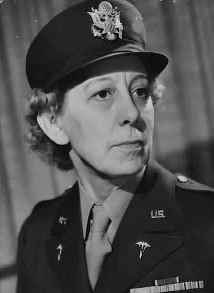 The attack on Pearl Harbor, on December 7, 1941, rocked the United States. It was so unexpected, but while it brought so much destruction, it also brought out so many heroes too. Orders did not need to be given, everyone simply jumped into action, without being told. Still, the destruction was so overwhelming, and the attack just kept coming. People were dodging bullets and bombs, as well as flying debris and suicide bombers. A heavy, choking, acrid smoke filled the air, making it very hard to breathe. There would be making deaths that day, but there would also be heroes.
The attack on Pearl Harbor, on December 7, 1941, rocked the United States. It was so unexpected, but while it brought so much destruction, it also brought out so many heroes too. Orders did not need to be given, everyone simply jumped into action, without being told. Still, the destruction was so overwhelming, and the attack just kept coming. People were dodging bullets and bombs, as well as flying debris and suicide bombers. A heavy, choking, acrid smoke filled the air, making it very hard to breathe. There would be making deaths that day, but there would also be heroes.
Lieutenant Annie G Fox was stationed at Hickam Airfield in Hawaii on December 7, 1941, and she was the chief nurse on duty that morning. When the attack began, she sprang into action to tend to the injured and dying service personnel on the base. For her outstanding performance, Fox was recommended for and awarded the Purple Heart, but she was not injured during the attack. Fox was presented the Purple Heart on October 26, 1942, at Hickam Field. Colonel William Boyd, Post Commander read the  citation which was commanded by Brigadier General W E Farthing and signed by Colonel L P Turner, Air Corps Executive Officer.
citation which was commanded by Brigadier General W E Farthing and signed by Colonel L P Turner, Air Corps Executive Officer.
Then, in 1944 in a horrible twist of fate, the rules for receiving the Purple Heart changed, and Fox no longer qualified. The recipient needed to have sustained battle wounds. Fox’s medal was rescinded. She received the Bronze Star instead. I can understand the reasons behind the change, but it seems wrong that her medal that was legitimately earned in 1941, could be taken back in 1944. It should have been grandfathered or something. Nevertheless, the Purple Heart was not returned.
Purple Heart or Bronze Star aside, Lieutenant Annie Fox showed great spirit that day. In the face of great  personal danger, she dodged the hail of bullets to reach many wounded people and she saved many lives. She could have been shot, bombed, breathed in poisonous gasses, or been hit by debris. It didn’t stop her. She saw the wounded, and she ran headlong into the danger, thereby saving her fellow man. Whether she was properly awarded the Purple Heart or not, she was definitely a hero.
personal danger, she dodged the hail of bullets to reach many wounded people and she saved many lives. She could have been shot, bombed, breathed in poisonous gasses, or been hit by debris. It didn’t stop her. She saw the wounded, and she ran headlong into the danger, thereby saving her fellow man. Whether she was properly awarded the Purple Heart or not, she was definitely a hero.
Annie Gayton Fox was born to Charles Fox and Deidamia (Gayton) Fox in East Pubnico, Nova Scotia, Canada, on August 4, 1893. She died at age 93 on January 20, 1987, in San Mateo County, California. Her years of service ran from July 3, 1918 through December 31, 1945. She retired as a Major in the US Army.

 Every wildfire takes with it many victims. Humans, of course, are the most tragic, but they also take animals, homes, and plant life. When a fire gets out of control, devastation will soon follow. Often, all we think about is the loss, and that is a terrible thing, but sometimes something happens that brings a degree of victory and elation to an otherwise horrible situation. Such was the case in the September 1, 1894 Hinckley, Minnesota fire. The loss of life was devastating, with some accounts saying 440 and others saying 418…partly because the Indians weren’t counted in that amount, and partly because there were people who were never found.
Every wildfire takes with it many victims. Humans, of course, are the most tragic, but they also take animals, homes, and plant life. When a fire gets out of control, devastation will soon follow. Often, all we think about is the loss, and that is a terrible thing, but sometimes something happens that brings a degree of victory and elation to an otherwise horrible situation. Such was the case in the September 1, 1894 Hinckley, Minnesota fire. The loss of life was devastating, with some accounts saying 440 and others saying 418…partly because the Indians weren’t counted in that amount, and partly because there were people who were never found.
The upper Midwest of the United States was a wooded area, rich in timber. Hinckley was a lumber and rail town, that had been built along the Grindstone River in Minnesota near the Wisconsin border. The main industry was the lumber business, and the slash cutting technique left behind it large amounts of wood debris. The town was nicknamed The Town Built Of Wood. Little did they know what a tragic nickname that would turn out to be. The lumber yards were built quite close to the railroad tracks, and the sparks from the 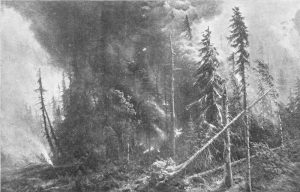 trains often set the wood debris on fire. Those fires were problematic, but no one expected the part the trains would play in 1894. That summer, a drought hit the Upper Midwest, making fires much more dangerous. The whole situation exploded on September 1, 1894, when fires near two rail lines south of Hinckley broke out, spreading north. When the raging fire reached the train depot, 350 of the residents got on a train to escape. The train passed right through flames, but reached safety in West Superior, Wisconsin. Were it not for this train, the loss of life would have been much higher. A number of the town’s residents took refuge in the swamps near town, but many of these people were killed, sadly some of them died by drowning. About 100 other residents fled to a gravel pit filled with water, and most of those people managed to survive. A train that was entering Hinckley from the north reversed direction to avoid the blaze. It still caught fire, and the only survivors were those who were able to jump from the train into a lake.
trains often set the wood debris on fire. Those fires were problematic, but no one expected the part the trains would play in 1894. That summer, a drought hit the Upper Midwest, making fires much more dangerous. The whole situation exploded on September 1, 1894, when fires near two rail lines south of Hinckley broke out, spreading north. When the raging fire reached the train depot, 350 of the residents got on a train to escape. The train passed right through flames, but reached safety in West Superior, Wisconsin. Were it not for this train, the loss of life would have been much higher. A number of the town’s residents took refuge in the swamps near town, but many of these people were killed, sadly some of them died by drowning. About 100 other residents fled to a gravel pit filled with water, and most of those people managed to survive. A train that was entering Hinckley from the north reversed direction to avoid the blaze. It still caught fire, and the only survivors were those who were able to jump from the train into a lake.
The fire burned 300,000 acres of town and forest, causing about $25 million in damages. In Hinckley, 228 people died, and another 200 in the surrounding areas, including 23 Ojibwa natives. It was a firestorm, with “as much force as an atomic bomb,” to quote a display at the town museum. Hinckley’s afternoon inferno also burned burned up five surrounding villages as it consumed over 400 square miles of kindling. It became known as the Great Hinckley Fire. A small group of statues in town represents survivors in the gravel pit. The Fire Monument and mass grave is on Fire Monument Road, very near the current interstate. Mass graves of 248 people are 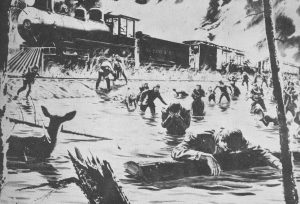
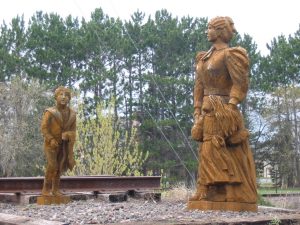 in lumpy mounds just behind the marker, dedicated in 1900 to the pioneers of civilization in Minnesota. Boston Corbett, killer of Abe Lincoln’s killer, is said to have left his “hole-in-the-ground home” in Kansas and died in the Great Hinckley Fire, in the neighboring town of Neodesha. The town of Hinckley has decided that the nickname The Town Built Of Wood is not one they want anymore, and their current slogan is “Relax…Have Fun!”
in lumpy mounds just behind the marker, dedicated in 1900 to the pioneers of civilization in Minnesota. Boston Corbett, killer of Abe Lincoln’s killer, is said to have left his “hole-in-the-ground home” in Kansas and died in the Great Hinckley Fire, in the neighboring town of Neodesha. The town of Hinckley has decided that the nickname The Town Built Of Wood is not one they want anymore, and their current slogan is “Relax…Have Fun!”
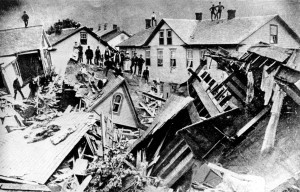 Over the years, man has tried many ways to harness water. Water is a necessity to life, and without it, all things would die off. Some projects worked out better than others, and some simply needed to be replaced sooner than they were in order to prevent disaster. A good example of that is the earthen dam. An earthen dam is a dam that is built out of rocks and dirt, instead of steel and concrete. Of course, when dams were first built, earthen dams were the only way to go, but after so many failed, a new type of dam had to be designed, in order to save lives. One such failure was the earthen dam built in 1840 on the Little Conemaugh River, fourteen miles upstream from Johnstown, Pennsylvania. Johnstown is sixty miles east of Pittsburgh, in a valley near the Allegheny, Little Conemaugh, and Stony Creek Rivers. The area lies in a floodplain that has had frequent disasters. This time would prove to be one of them. At nine hundred by seventy two feet, this dam was the largest earthen dam in the United States, creating the largest man-made lake at that time…Lake Conemaugh. At a time when here were no railroads in the area for transporting goods, the dam and its extensive canal system was the only way to transport goods to the people, but it became obsolete as the railroads replaced the canal as a means of transporting goods. The canal system was left to become a victim of the elements, and with its neglect, also came the neglect of the dam. In reality, people just didn’t really think anything would happen, and they most likely looked at the dam as just a part of the landscape.
Over the years, man has tried many ways to harness water. Water is a necessity to life, and without it, all things would die off. Some projects worked out better than others, and some simply needed to be replaced sooner than they were in order to prevent disaster. A good example of that is the earthen dam. An earthen dam is a dam that is built out of rocks and dirt, instead of steel and concrete. Of course, when dams were first built, earthen dams were the only way to go, but after so many failed, a new type of dam had to be designed, in order to save lives. One such failure was the earthen dam built in 1840 on the Little Conemaugh River, fourteen miles upstream from Johnstown, Pennsylvania. Johnstown is sixty miles east of Pittsburgh, in a valley near the Allegheny, Little Conemaugh, and Stony Creek Rivers. The area lies in a floodplain that has had frequent disasters. This time would prove to be one of them. At nine hundred by seventy two feet, this dam was the largest earthen dam in the United States, creating the largest man-made lake at that time…Lake Conemaugh. At a time when here were no railroads in the area for transporting goods, the dam and its extensive canal system was the only way to transport goods to the people, but it became obsolete as the railroads replaced the canal as a means of transporting goods. The canal system was left to become a victim of the elements, and with its neglect, also came the neglect of the dam. In reality, people just didn’t really think anything would happen, and they most likely looked at the dam as just a part of the landscape.
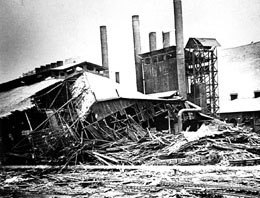
By 1889, Johnstown had grown to a population of 30,000 people, many of whom worked in the steel industry…ironically. On May 30, 1889, it began to rain, and continued steadily all day. No one really gave any thought the potential harm so much rain could bring to the nearly sixty year old earthen dam. The dam had a spillway, and so everything seemed safe, but the spillway became clogged with debris, that could not be dislodged. On May 31, 1889, an engineer at the dam saw the warning signs, but the only way to notify anyone was to ride his horse into the village of South Fork to warn the people…a ride that took an eternity in the face of the impending disaster. Nevertheless, it should have been enough time, but the telegraph lines were down, and no warning ever reached Johnstown. At 3:10pm, the dam collapsed with a roar that could be heard for miles. The water, moving at 40 miles per hour barreled down on the towns in it’s path, wiping out everything that got in its way. At Johnstown, 2,200 people lost their lives that day, including one Thomas Knox and his wife. Thomas, like a large number of the flood victims was never found. While I’m not sure that Thomas Knox is related to my husband, Bob Schulenberg’s family, it is quite likely that he is, as there are a number of Thomas Knox’s in the family…though none that I have found so far that died in the Johnstown Flood.
The people in the path of the raging flood waters, were tossed around, along with all that debris, including thirty three train engines that were pulled into the flood waters. I’m sure that for many, death did not come 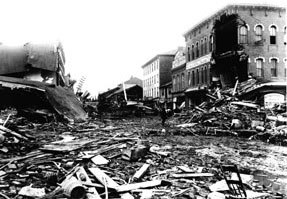 from drowning, but rather from blunt force trauma. Nevertheless, some people did manage to climb atop the debris, only to be burned alive when much of the debris caught fire, when it was caught in a bridge downstreem and burst into flames. There was a report of a baby that survived on the floor of a house that floated 75 miles downstream, but that was something that was not confirmed. It was during the Johnstown flood, that the American Red Cross handled its first major relief effort. Clara Barton arrived five days after the flood to lead the relief. In the end, it took five years to rebuild Johnstown, which went through disastrous floods in 1936 and 1977. I have to wonder if they should just move the town, but with no major floods since 1977, it’s hard to say.
from drowning, but rather from blunt force trauma. Nevertheless, some people did manage to climb atop the debris, only to be burned alive when much of the debris caught fire, when it was caught in a bridge downstreem and burst into flames. There was a report of a baby that survived on the floor of a house that floated 75 miles downstream, but that was something that was not confirmed. It was during the Johnstown flood, that the American Red Cross handled its first major relief effort. Clara Barton arrived five days after the flood to lead the relief. In the end, it took five years to rebuild Johnstown, which went through disastrous floods in 1936 and 1977. I have to wonder if they should just move the town, but with no major floods since 1977, it’s hard to say.

